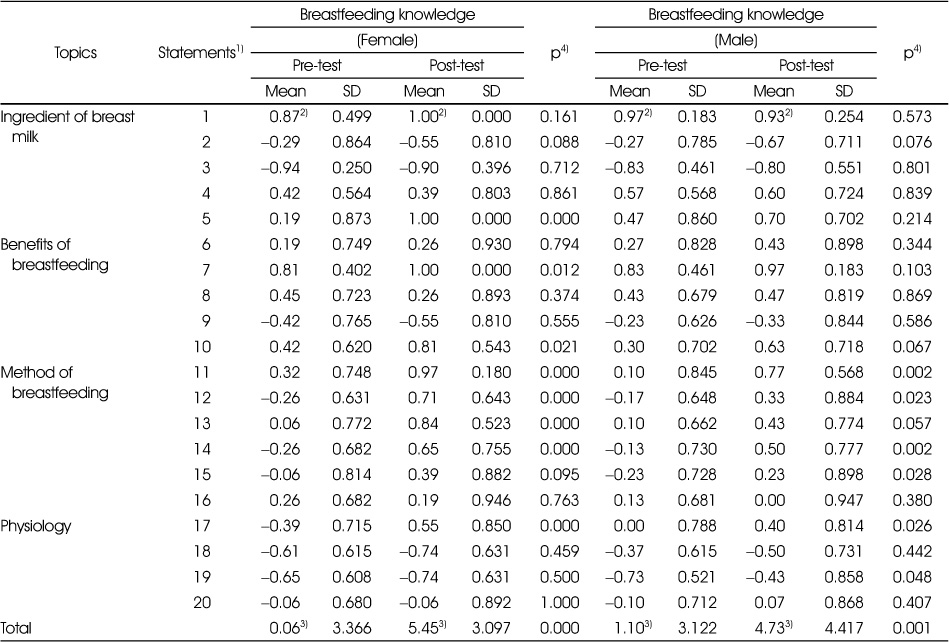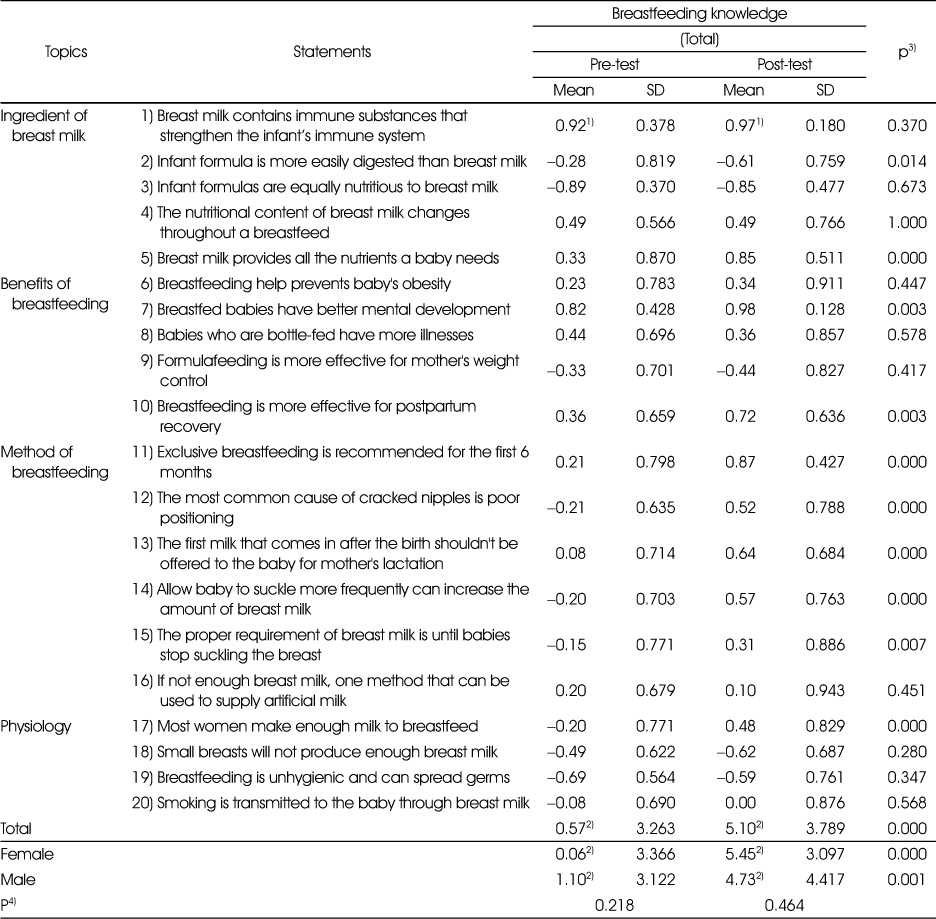Articles
- Page Path
- HOME > Korean J Community Nutr > Volume 23(1); 2018 > Article
-
Research Article
- Effects of Educational Intervention about Breastfeeding on University Students' Knowledge and Attitudes toward Breastfeeding: Focusing on Gender Differences
-
Jo-Yoon Lee

-
Korean Journal of Community Nutrition 2018;23(1):1-12.
DOI: https://doi.org/10.5720/kjcn.2018.23.1.1
Published online: February 28, 2018
Major of Hotel & Foodservice Industry, Joongbu University, Chungnam, Korea.
- Corresponding author: Jo-Yoon Lee. Major of Hotel & Foodservice Industry, Joongbu University 201 Daehak-ro, Chubu-myeon, Geumsan-gun, Chungnam 32713, Korea. Tel: (041) 750-6729, Fax: (041) 750-6380, joyoon@joongbu.ac.kr
Copyright © 2018 The Korean Society of Community Nutrition
This is an Open-Access article distributed under the terms of the Creative Commons Attribution Non-Commercial License (http://creativecommons.org/licenses/by-nc/3.0/) which permits unrestricted non-commercial use, distribution, and reproduction in any medium, provided the original work is properly cited.
- 922 Views
- 4 Download
Abstract
-
Objectives
- The purpose of this study was to examine the impact of a targeted, practical education intervention on university students' knowledge and attitudes toward breastfeeding.
-
Methods
- A university curricular intervention was designed for students to increase their knowledge and positive attitude toward breastfeeding issues. The participants attended a breastfeeding education lectures two hours of weekly for fifteen weeks in university; 61 students (female, n=31 and male, n=30) participated. The pre- and post-measurements included future breastfeeding intention, knowledge, attitude and perceived control beliefs scores based on the results of a questionnaire.
-
Results
- The statistical analysis results revealed a significant difference in the pretest and posttest scores (0.57 to 5.10 points, p<0.001) in regard to the students' breastfeeding knowledge. For female students, significant differences were observed in the future breastfeeding intention (p<0.05), knowledge (p<0.001), and attitudes towards breastfeeding (p<0.05) between the pretest and posttest scores. For male students, there were no significant differences in the future breastfeeding intention, attitudes towards breastfeeding, and perceived control beliefs scores after the breastfeeding education lecture.
-
Conclusions
- This study showed that the implementation of practical breastfeeding educational interventions helped improve university students' knowledge and attitudes toward breastfeeding. In summary, despite the limitations, it is necessary to pay more attention to improving students' knowledge and attitudes towards breastfeeding through university curricula.
- 1. WHO. Global nutrition targets 2025: Breastfeeding policy brief. Geneva: World Health Organization; 2014. p. 1.
- 2. Lee SS. The 2015 National Survey on Fertility and Family Health and Welfare. Korea Inst Health Soc Affairs; 2015. p. 201.
- 3. Choi EJ. Breastfeeding-related social environmental factors and their policy implications. Korea Inst Health Soc Affairs 2017; 249: 72-81.
- 4. Jang MK, Lee SM, Khil JM. Belief factors associated with breastfeeding intentions of single women: Based on the theory of planned behavior. J Nutr Health 2017; 50(3): 284-293.ArticlePDF
- 5. Kim JE, Park DY. A study on predicting behavioral intention of breastfeeding among primigravida. Korean J Community Nutr 2001; 6(3): 331-339.
- 6. Kim JE, Park DY. A study on the experience of breastfeeding education for women with children 24 months of age and younger. Korean J Community Living Sci 2012; 23(4): 523-535.Article
- 7. Kim SH, Choi ES, Kim TH. The knowledge and attitude on breast feeding of female university students. J Korean Acad Womens Health Nurs 2001; 7(1): 93-106.ArticlePDF
- 8. Choi KS, Lee HJ. A study on knowledges and attitudes about breast milk feeding and needs for breast milk feeding education among high school students. Korean J Community Nutr 2006; 11(2): 191-204.
- 9. Song BC, Cho JH, Lee IY, Kim MK. A study on knowledges on breast feeding of college students by their general characteristics. J Korean Soc Food Cult 2008; 23(2): 268-272.
- 10. Devi G. Effectiveness of education programme on students' breastfeeding attitude. Int J Nurs Educ 2017; 9(2): 98-101.Article
- 11. Bozzette M, Posner T. Increasing student nurses' knowledge of breastfeeding in baccalaureate education. Nurse Educ Pract 2013; 13(3): 228-233.ArticlePubMed
- 12. Cattaneo A. Academy of breastfeeding medicine founder's lecture 2011: inequalities and inequities in breastfeeding: an international perspective. Breastfeed Med 2012; 7(1): 3-9.ArticlePubMed
- 13. Čatipović M, Bariĉić TV, Rokvi S, Grguri J. Adolescents' knowledge of breastfeeding and their intention to breastfeed in the future. Children (Basel) 2017; 4: E51.
- 14. Juliff D, Downie J, Rapley P. Knowledge and attitudes of secondary school students to breastfeeding. Neonatal Paediatr Child Health Nurs 2007; 10(3): 13-18.
- 15. Lee JY, Lee KW, Hyun WJ. A study on knowledge and control beliefs regarding breastfeeding of university students by their general characteristics and experienced education in breastfeeding. Korean J Community Nutr 2013; 18(5): 457-466.Article
- 16. Davis A, Roy AS. Effects of an educational intervention on baccalaureate nursing students' knowledge and attitude in providing breastfeeding support to mothers. Int J Childbirth Educ 2015; 30(4): 8-12.
- 17. Giles M, Connor S, Mc.-Clenahan C, Mallett J, Stewart-Knox B, Wright M. Measuring young people's attitudes to breastfeeding using the Theory of Planned Behaviour. J Public Health (Oxf) 2007; 29(1): 17-26.ArticlePubMed
- 18. WHO. Infant and young child feeding -Model Chapter for textbooks. World Health Organization; 2009.
- 19. Spatz DL. The breastfeeding case study: A model for educating nursing students. J Nurs Educ 2005; 44(9): 432-434.ArticlePubMed
- 20. UNICEF. A breastfeeding counsellor helps a mother with her positioning and attachment whilst breastfeeding [Internet]. United Kingdom Committee for UNICEF; 2013; cited 2018 Feb 2]. Available from: https://www.unicef.org.uk/babyfriendly/baby-friendlyresources/video/.
- 21. Baby center. 5 simple breastfeeding positions [Internet]. Baby center; 1997; 2018; updated 2017 Jan]. cited 2018 Feb 2]. Available from: https://www.babycenter.com/2_5-simple-breastfeedingpositions_10418636.bc.
- 22. La Leche League International. How do I position my baby to breastfeed [Internet]?. La Leche League International; 2011; updated 2014 Nov. 16]. cited 2018 Feb 2]. Available from: http://www.llli.org/faq/positioning.html.
- 23. Dungy CI, McInnes RJ, Tappin DM, Wallis AB, Oprescu F. Infant feeding attitudes and knowledge among socioeconomically disadvantaged women in Glasgow. Matern Child Health J 2008; 12(3): 313-322.ArticlePubMedPDF
- 24. Vijayalakshmi P, Susheela T, Mythili D. Knowledge, attitudes, and breast feeding practices of postnatal mothers: A cross sectional survey. Int J Health Sci (Qassim) 2015; 9(4): 364-374.ArticlePubMedPMC
REFERENCES
The difference of gender in breastfeeding knowledge by the educated participants

1) Statements were same as in Table 4.
2) Range: −1 (low)~1 (high); −1: incorrect, 0: don't know, 1: correct
3) Total scored on a scale: −20~20 points
4) Independent t-test between pre-test and post-test
Figure & Data
REFERENCES
Citations

Course schedule and topics
Demographic characteristics of the study participants
1) F: Female
2) M: Male
Comparison of future breastfeeding intentions by the educated participants
1) Mean ± SD, range: 0 (low) − 5 (high); 1: strongly disagree, 2: disagree, 3: normal, 4: agree 5: strongly agree.
2) Independent t-test between female and male
3) Independent t-test between pre-test and post-test
*: p<0.05
The difference in breastfeeding knowledge by the educated participants
1) Range: −1 (low)~1 (high); −1: incorrect, 0: don't know, 1: correct
2) Total scored on a scale: −20~20 points
3) Independent t-test between pre-test and post-test
4) Independent t-test between female and male
The difference of gender in breastfeeding knowledge by the educated participants
1) Statements were same as in
2) Range: −1 (low)~1 (high); −1: incorrect, 0: don't know, 1: correct
3) Total scored on a scale: −20~20 points
4) Independent t-test between pre-test and post-test
The difference in breastfeeding attitude by the educated participants
1) Mean ± SD
2) range: 0 (low) − 5 (high); 1: strongly disagree, 2: disagree, 3: normal, 4: agree 5: strongly agree.
3) range: 0 (low) − 5 (high); 1: very impossible, 2: impossible, 3: normal, 4: possible, 5: very possible
The difference in breastfeeding perceived control by the educated participants
1) Mean ± SD
2) range: 0 (low) − 5 (high); 1: very difficult, 2: difficult, 3: normal, 4: easy, 5: very easy
3) range: 0 (low) − 5 (high); 1: very impossible, 2: impossible, 3: normal, 4: possible, 5: very possible
1) F: Female 2) M: Male
1) Mean ± SD, range: 0 (low) − 5 (high); 1: strongly disagree, 2: disagree, 3: normal, 4: agree 5: strongly agree. 2) Independent t-test between female and male 3) Independent t-test between pre-test and post-test *: p<0.05
1) Range: −1 (low)~1 (high); −1: incorrect, 0: don't know, 1: correct 2) Total scored on a scale: −20~20 points 3) Independent t-test between pre-test and post-test 4) Independent t-test between female and male
1) Statements were same as in 2) Range: −1 (low)~1 (high); −1: incorrect, 0: don't know, 1: correct 3) Total scored on a scale: −20~20 points 4) Independent t-test between pre-test and post-test
1) Mean ± SD 2) range: 0 (low) − 5 (high); 1: strongly disagree, 2: disagree, 3: normal, 4: agree 5: strongly agree. 3) range: 0 (low) − 5 (high); 1: very impossible, 2: impossible, 3: normal, 4: possible, 5: very possible
1) Mean ± SD 2) range: 0 (low) − 5 (high); 1: very difficult, 2: difficult, 3: normal, 4: easy, 5: very easy 3) range: 0 (low) − 5 (high); 1: very impossible, 2: impossible, 3: normal, 4: possible, 5: very possible

 KSCN
KSCN






 Cite
Cite


